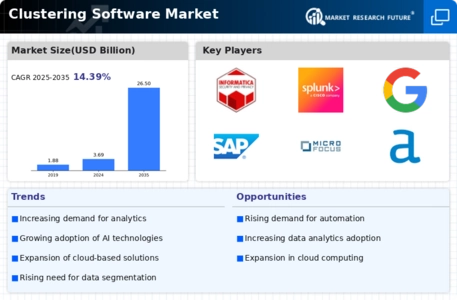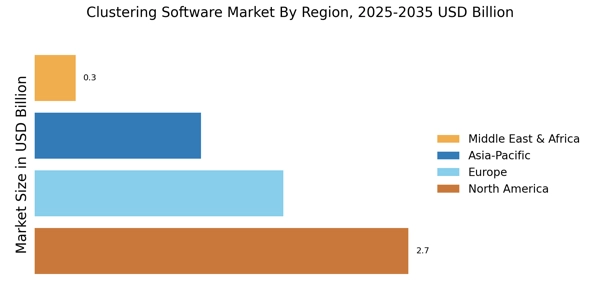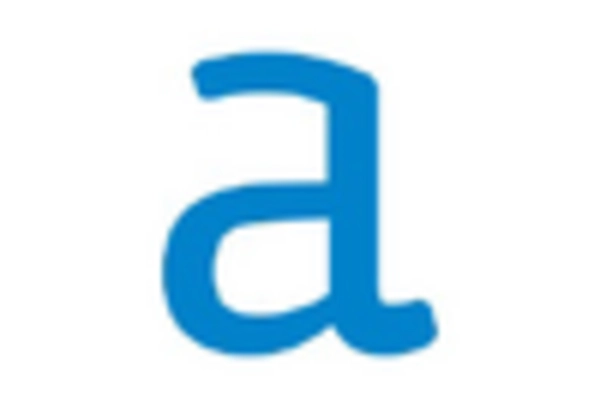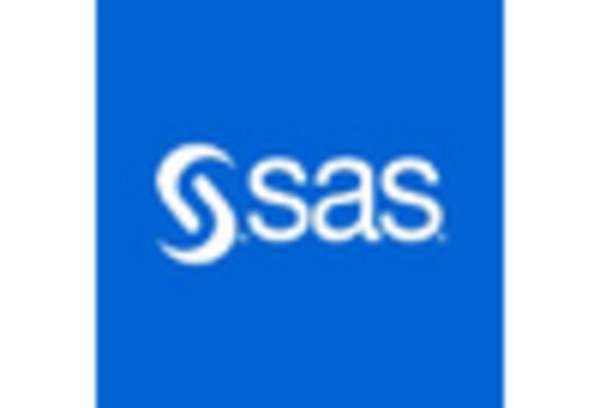The Clustering Software Market is currently characterized by a dynamic competitive landscape, driven by the increasing demand for data analytics and machine learning capabilities across various industries. Key players such as IBM (US), Microsoft (US), and Oracle (US) are strategically positioned to leverage their technological expertise and extensive resources. IBM (US) focuses on innovation through its Watson platform, which integrates AI and machine learning to enhance clustering capabilities. Meanwhile, Microsoft (US) emphasizes partnerships and cloud-based solutions, particularly through Azure, to provide scalable clustering software that meets diverse customer needs. Oracle (US) is also enhancing its offerings by integrating advanced analytics into its cloud services, thereby solidifying its market presence. Collectively, these strategies indicate a trend towards comprehensive solutions that not only address clustering needs but also integrate seamlessly with broader data management frameworks.
In terms of business tactics, companies are increasingly localizing their operations and optimizing supply chains to enhance service delivery and reduce latency. The market structure appears moderately fragmented, with a mix of established players and emerging startups vying for market share. This fragmentation allows for innovation and niche solutions, although the influence of major players remains substantial. The collective actions of these key players shape a competitive environment that is both challenging and ripe for growth, as they continuously adapt to evolving customer demands and technological advancements.
In August 2025, IBM (US) announced a significant upgrade to its Watson Studio, enhancing its clustering algorithms to support more complex data sets. This upgrade is strategically important as it positions IBM to cater to industries requiring advanced analytics, such as healthcare and finance, where data complexity is increasing. By improving its clustering capabilities, IBM not only strengthens its product offering but also reinforces its commitment to innovation in AI-driven analytics.
In September 2025, Microsoft (US) launched a new feature within its Azure Machine Learning service that allows users to create custom clustering models with minimal coding. This move is indicative of Microsoft's strategy to democratize data science, making advanced analytics accessible to a broader audience. By simplifying the user experience, Microsoft is likely to attract small to medium-sized enterprises that may have previously found such technologies daunting, thereby expanding its market reach.
In July 2025, Oracle (US) entered into a strategic partnership with a leading cloud service provider to enhance its clustering software capabilities. This collaboration aims to integrate Oracle's advanced analytics with the partner's cloud infrastructure, facilitating faster data processing and improved clustering outcomes. Such partnerships are crucial as they enable Oracle to leverage external expertise and resources, thereby enhancing its competitive edge in the market.
As of October 2025, the Clustering Software Market is witnessing trends that emphasize digitalization, sustainability, and the integration of AI technologies. Strategic alliances are increasingly shaping the competitive landscape, allowing companies to pool resources and expertise to deliver more robust solutions. Looking ahead, it appears that competitive differentiation will evolve from traditional price-based strategies to a focus on innovation, technological advancement, and supply chain reliability. This shift suggests that companies that prioritize these aspects are likely to thrive in an increasingly complex and competitive environment.


















Leave a Comment